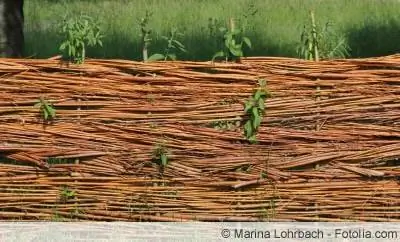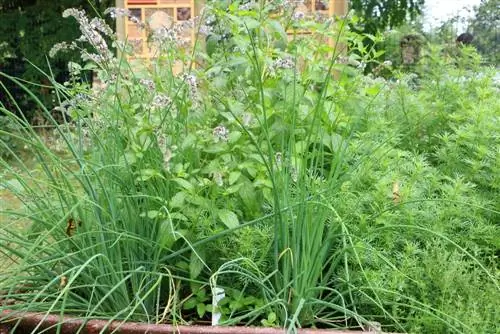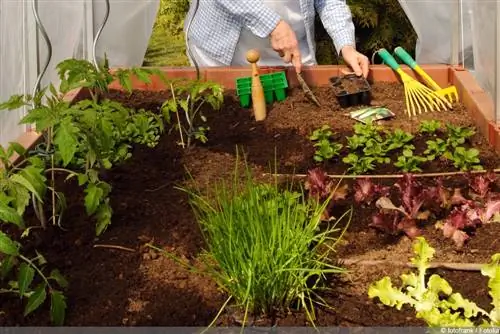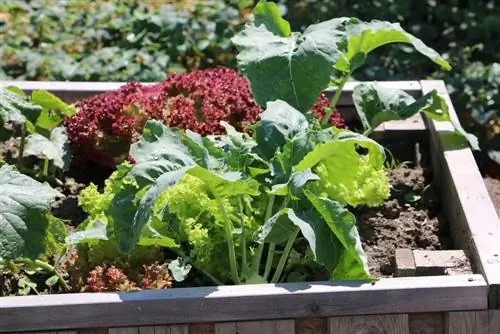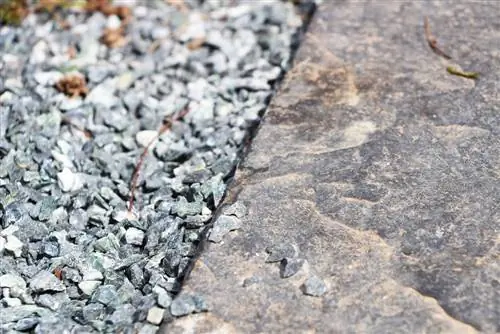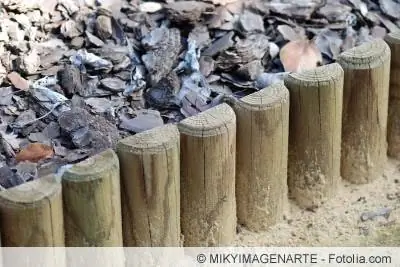- Author admin [email protected].
- Public 2023-12-17 03:39.
- Last modified 2025-01-24 12:45.
When building a flower or vegetable bed, the question of a suitable bed border quickly arises. A natural design option is a willow bed border, which is particularly suitable for cottage gardens. With a little craftsmanship, any gardener can build such a border themselves in no time. Willow wood is extremely weather-resistant and very durable, an ideal natural product for the garden. In the same way that a bed border can be made from willow, a willow fence can also be created as a boundary and privacy screen.
Willow rods
To build a willow border or a willow fence, you first need suitable willow rods. If the willow branches are no longer supposed to sprout and the border and fence are to remain the same, then the willow branches must have been dried for a long time. This causes them to lose their elasticity, but this can be restored later. The following criteria play an important role in the willow rods:
- Willow is extremely flexible and at the same time robust
- Willow rods can often be purchased very inexpensively from building yards
- Landscaping companies also often offer willow rods quite cheaply
- Pruning the willow branches is ideal between the end of October and the beginning of March
- When cut from late autumn to early spring, these have no leaves
- Optimal length of the willow rods is between 2-3 m, thickness approx. 1-2 cm
- Braided willow rods are used to separate beds and the lawn
- Willow wickerwork can be built into large-scale fences
Willow bed border
The willow bed border can be used to border both vegetable and flower beds and create the ambience of a traditional cottage garden in the bed. Due to the good weather resistance of the willow branches, the gardener will be able to enjoy his bed border for a long time, provided it has been set up correctly. This small woven bed border protects the plantings from strong winds and heavy rain, and the border is also very decorative and fits harmoniously into natural gardens. The following aspects must be taken into account when edging the beds:
- Materials required: pruning shears, willow sticks about the thickness of a finger, stakes, tension cord and sledgehammer
- First create a basic construction
- Drive stakes vertically into the ground
- Tighten a guide line beforehand to align the pegs exactly
- To hammer in the pegs, place a wooden board on the front side
- Board protects the wooden pegs from damage
- Drive in between 3-5 wooden stakes per meter of the bed border
- The closer the stakes are, the more stable the bed border is
- However, do not place them too tightly, otherwise it will be too difficult to weave in the willow branches
Tip:
A willow bed border is also very suitable as a border and bank reinforcement for ponds.
Willow braiding

After inserting the wooden pegs, the phase in which the willow branches have to be braided begins. The individual rows can either be braided in opposite directions or the thin and thick ends of the willow branches are only changed after several rows, in this way an attractive braided pattern is created. The following criteria are crucial when braiding:
- Always place the start and end of the willow branches close to the post
- Short the rods with pruning shears if necessary
- Always alternate the ends of the rods so that the thicker ends meet the thinner ends
- Make sure that the overall appearance is even and harmonious when braiding
- After braiding a few rows, place a wooden board on top and hit it with a hammer
- Beating makes the braid of the rods thicker
Tip:
If the willow branches are no longer fresh but are already very dry, they are very difficult to bend. In this case, place the willow branches in a water bath overnight to make them more flexible again.
Make your own wicker fence
A woven willow fence creates a natural-looking separation in the garden, which is reminiscent of the structures of old cottage gardens. Such a fence also serves as a decorative privacy screen and creates cozy nooks and niches in a larger garden area. With a low woven willow fence you can take away the linear severity of geometric structures. The natural product is weather-resistant and sets natural accents in all gardens. The production and construction are similar to the bed edging, but the proportions change and the structure must be more firmly secured. If no shoots are desired, the willow branches must be braided horizontally so that the material does not come into contact with the soil:
- Materials required: axe, wooden stakes, thin and leaf-free willow rods for weaving, large hammer, wooden board for impact protection, iron rod or auger, guide line, spirit level
- Select stable and straight wooden pegs
- Stakes made of oak, hazelnut, chestnut and robinia are ideal
- Strong round posts with a length of up to 2.50 m are ideal for the basic construction
- Privacy walls must be able to withstand strong gusts of wind
- For straight alignment, stretch a guide line as a practical guide
- Sharpening the handles with an ax
- Use an earth auger or thick iron rod to create the holes in the ground, it makes driving in easier
- Use a hammer to drive in the stakes vertically
- Depending on the length of the stakes, an insertion depth of 30-50 cm is necessary
- Check the correct alignment every now and then with a spirit level
- Then weave in the willow branches
Tip:
If there is already a safe and wind-stable metal mesh fence in the garden, then the elastic willow rods can be woven into it; the willow material gives the cold-looking steel a natural charm.
Living willow fence
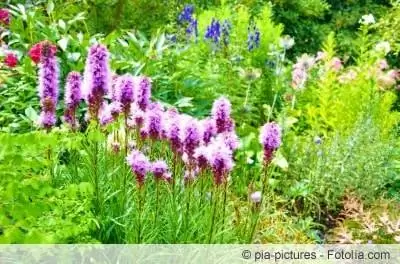
If live willow stakes are used when building the willow fence, they will sprout after a while if the site conditions are suitable. In this way, the fence looks even more natural and grows taller over the years. However, the willow material can only sprout in vertical wicker fences. A living willow fence is a cheap and environmentally friendly alternative to fence construction. Due to natural growth, new willow branches are constantly being created, which can be used and processed in different ways, e.g. B. for bed borders and climbing aids. The construction of a living willow fence requires careful preparation, and it also requires regular maintenance after completion:
- Living willow fence can be used as a privacy screen and property demarcation
- There are around 450 different types of willow
- Willow bark can have shades of light yellow, green, purple and red
- If space is limited, prefer weakly growing willow species
- Replace pastures that do not want to grow as soon as possible
- Proceed as with a conventional wattle fence, but use thick willow branches as stakes
- Insert the braided structure vertically, allowing constant contact with the ground
- Use willow branches from February to the beginning of April, after the strongest frost nights
- Soak rods for at least 12 hours beforehand
- Dig deep plug-in holes to sink one third of the rods into the ground
- The deeper, the better the roots root and the more grip they have afterwards
- Make sure the direction of growth is correctly observed when inserting
- Plan distances of approx. 40 cm between the rods
- Afterwards attach the weave
- Mixture of horizontally and vertically braided willow rods possible
- Horizontal rods don't drive out
- Water regularly and thoroughly in the first period after planting
- The willow branches normally sprout within six months
- Newly growing shoots can be woven into the fence or used for other purposes
Conclusion
Willow is an attractive natural material that allows for a particularly wide range of creative uses in the garden. Braided willow rods can be used to create natural boundaries between the different beds or between the beds and the adjacent lawn. Ambitious gardeners can use the wickerwork to create interesting structures when edging their beds that fit harmoniously between the plants. It is always important to have a stable basic structure so that wind and weather cannot cause any damage. When creating the electric fence, it can also be designed as a living structure if the woven willow branches are stuck vertically into the ground. However, these willow branches must still be relatively fresh; completely dry branches will no longer sprout. After an extensive water bath, even slightly dried willow branches can be made flexible and elastic again so that braiding is easier by hand. Braided willow bed borders and willow fences are reminiscent of rustic cottage gardens and convey an original charm.

